Hitler’s Quest for Power Was Nearly Derailed Multiple Times.
But the System Enabled His Rise
 |
| Adolf Hitler is welcomed by supporters at Nuremberg in 1933 |
In the end, however, his astonishing success showed how demagoguery could overcome potentially career-ending challenges—and profoundly change history. A determined strongman, not taken seriously by the elites but enabled by a core of passionate supporters, could bend events his way just as his country went into free-fall. Hitler’s seemingly improbable ascent is an object lesson in the volatility of history.
While researching my new book on the radical Nazi’s rise, I was stunned at the number of times Hitler’s quest for power almost came to an end—and how close the world came, it seems, to avoiding the terror he caused. The first was in 1923, when he staged an ill-fated coup d’état that became known as the Beer Hall Putsch. It failed within 17 hours. Twenty men were killed, and Hitler missed being hit in a barrage of police bullets by only two feet. The man next to him died. Hitler threatened suicide and, in prison, attempted a hunger strike. In the end, he stood trial and was convicted of treason.
That event should have ended Hitler’s political career. But the Nazi chief was a fanatic. Convinced of his messianic mission to save Germany from imminent downfall, he wrote an autobiographical manifesto called Mein Kampf, obtained early parole from prison and refounded the Nazi movement in 1925. Hitler’s party drew true believers and grew. Yet in 1926, he faced an internal insurrection and possible party splintering. At the last minute, he quelled the challenge with a four-hour stemwinder at a closed Nazi meeting.
A year later, the Nazi Party was broke. Hitler again considered suicide, telling his new acolyte, Joseph Goebbels, that he would rather put a bullet into his head than accept bankruptcy. He was saved by a rich industrialist, Emil Kirdorf. Motivated by a four-hour Hitler monologue delivered at a Munich mansion, Kirdorf reportedly gave the Nazi Party 100,000 marks—$350,000 in today’s money.
In 1928, Hitler led his radical band into national elections—and fell flat. Preaching doom and downfall, Hitler swam against the historical tide. Germany’s economy was rebounding. The Nazis won only 2.6% of the vote, hitting rock bottom.
Even after the Great Depression prompted a turnaround for the flailing party—by 1930, the Nazis had won 18.3% in a national election—he faced another mutiny within the party and then, in 1931, a scandal prompted by the suicide of his 23-year-old niece, Geli Raubal, who was assumed by many to be his lover. The political roller-coaster ride continued. In 1932, Hitler’s Nazis reached a peak of 37% of the parliamentary vote, but Hitler’s refusal to be part of a coalition led the party to shed two million votes in the year’s final election.
After Hitler’s top lieutenant, Gregor Strasser, dramatically defected, threatening a party break-up, the Nazi leader’s meteoric political rise seemed at an end. “It is obvious that [Hitler] is now headed downhill,” wrote a leading newspaper. “The republic has been rescued.”
Even Goebbels was devastated. “The year 1932 has been one long streak of bad luck,” he wrote. “We just have to smash it to pieces.”
But to the amazement of many, Hitler was not dead yet.
By January 1933, German politics was in a tailspin—unemployment had hit 24%, with 6 million out of work. A new government was desperately needed. After a series of clandestine meetings of behind-the-scenes political players in a posh Berlin villa, Hitler emerged as the secret choice to be appointed chancellor by President Paul von Hindenburg.
However, the secret arrangement depended on a delicately balanced, multi-party cabinet. Then, just hours before his scheduled swearing in by President Hindenburg, the Nazi leader demanded that his prospective cabinet ministers agree to new elections within six weeks—a move that would affirm the Nazis’ hold on power. It was a stunning last-second condition, yet all agreed except Alfred Hugenberg, who was to be minister of economics and agriculture. The stubborn old politician, 24 years Hitler’s senior, distrusted the noisy Nazi and did not want to give him an even freer hand.
The deal for Hitler to take power now threatened to become unraveled, yet again.
Without Hugenberg, everyone knew, there would be no cabinet, no government, no swearing-in.
As Hitler and the cabinet members entered the chancellery, where the 84-year-old Hindenburg waited for them, the president’s top aide rushed up, his pocket watch in hand. “Gentlemen, you can’t keep the president waiting any longer,” he said.
Suddenly Hugenberg, a man of the old school who revered manners, authority and age, accepted Hitler’s conditions. Hitler’s last brush with political obscurity was averted. Over the prior two decades, he had relied on luck and rhetoric to save his career time and again—but behind those factors lay, always, a larger context of German politics that enabled his rise. His speeches could head off a mutiny, but the success or failure of the German economy held more sway over the fortunes of the Nazi Party. And here, once again, was a moment when Hitler’s mania for power did not succeed alone, but instead with the help of a system that let it happen. Within 15 minutes, he had become chancellor of Germany, setting the stage for the horrors that followed.
The following day, Hugenberg told a friend: “Yesterday, I did the stupidest thing of my life. I joined forces with the greatest demagogue in world history.”
Peter Ross Range, a former TIME correspondent, is the author of The Unfathomable Ascent: How Adolf Hitler Came to Power, available now from Little Brown and Company.
No comments:
Post a Comment